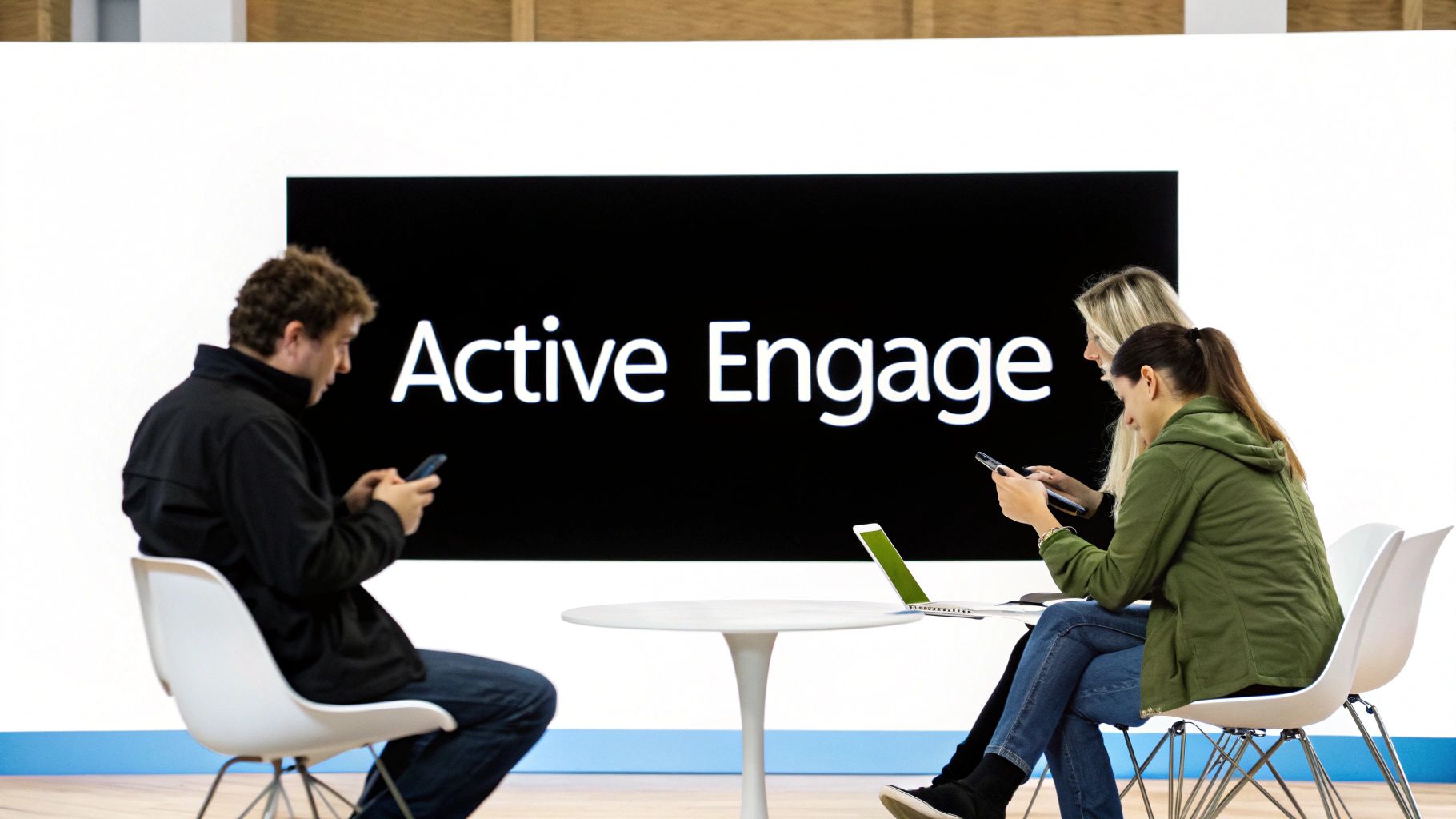Unlocking the Power of a Compelling Executive Bio
Your executive bio is your digital introduction to the world. For CTOs, CEOs, startup founders, and entrepreneurs, it’s more than just a list of jobs and dates. It’s a strategic narrative that can significantly advance your career. Executive bios have evolved from simple biographical summaries into dynamic tools for personal branding and influence. They reflect how we connect and communicate today. In a split second, your bio can determine whether a potential investor, partner, or client wants to learn more, ultimately impacting your business.
A truly effective bio captures your unique leadership journey, showcases your achievements, and resonates with your target audience. It does all of this while maintaining a professional and credible tone.
The rise of online professional networking platforms like LinkedIn has changed how we present ourselves professionally. Executive bios are no longer static resumes. They exist in a dynamic, interconnected online ecosystem. This requires a deeper understanding of how different formats and approaches can maximize visibility and impact.
Crafting a Narrative That Resonates
In this article, we’ll explore eight different executive bio examples, each with a unique purpose and target audience. We’ll cover crafting compelling narratives and highlighting key accomplishments. We’ll also discuss optimizing for online platforms and showcasing your leadership philosophy. By examining these diverse approaches, you’ll discover how to create an executive bio that not only reflects your experience but actively contributes to your professional success.
1. Narrative Storytelling Bio

For executives seeking a bio that truly resonates, the narrative storytelling approach offers a compelling alternative to a traditional list of achievements. Instead of dryly reciting accomplishments, this format transforms your career path into a captivating story. It highlights your journey, the obstacles overcome, and the pivotal moments that shaped your direction.
This style uses narrative techniques to forge an emotional connection with readers, making your bio not just informative, but also inspiring and relatable. This is essential for establishing genuine relationships with your audience, including potential investors, clients, or partners.
This approach has gained significant traction, notably among TED speakers, entrepreneurs in creative and tech fields, and executive coaches and consultants. They’ve effectively leveraged personal anecdotes and shared experiences to demonstrate the power of storytelling in fostering trust and building thought leadership.
Consider Richard Branson’s bio, often filled with his entrepreneurial exploits, or Oprah Winfrey’s inspiring journey from humble beginnings to media mogul. Sara Blakely, founder of Spanx, also uses narrative, with the famous story of cutting the feet out of her pantyhose as a compelling origin story. These illustrate how a strong narrative captivates audiences and creates a memorable impact.
Features of a Narrative Storytelling Bio
- First-Person or Third-Person Narrative Style: Choose the perspective that best reflects your voice and brand.
- Chronological Flow with Dramatic Elements: Structure your story with a beginning, rising action, climax, and resolution, weaving in moments of challenge and success.
- Personal Anecdotes and Professional Achievements: Find a balance between personal insights and concrete accomplishments to illustrate how your experiences have contributed to your career growth.
- Strong Opening Hook and Memorable Conclusion: Capture attention from the outset and leave a lasting impression.
- Length (300-500 words): While there’s some flexibility, this range allows ample room for storytelling while respecting the reader’s time.
Pros:
- Creates an emotional connection with the audience
- Memorable and distinctive compared to standard corporate bios
- Effectively communicates personal brand and values
- Humanizes the executive
- Particularly impactful for keynote speakers and thought leaders
Cons:
- Might be perceived as too informal in certain traditional industries
- Requires strong writing skills or the assistance of a professional writer
- Can become excessively long without careful editing
- Potential risk of oversharing personal information
Tips for Implementation:
- Focus on 2-3 Key Moments: Don’t attempt to include your entire life story. Select the most impactful experiences that showcase your core values and motivations.
- Include Specific Results and Metrics: While storytelling is crucial, support your narrative with tangible achievements and quantifiable outcomes to build credibility.
- Professional Tone with Personality: Maintain professionalism while injecting your authentic personality.
- Peer Review: Before publishing, seek feedback on the tone and content from trusted colleagues to ensure an appropriate level of personal disclosure.
- Cross-Platform Consistency: Ensure your narrative remains consistent across your website, LinkedIn profile, and other online platforms.
The Narrative Storytelling Bio is a valuable tool for executives, especially CTOs, CEOs, startup founders, and entrepreneurs, to connect with their audience more deeply. Sharing your journey authentically and strategically builds trust, positions you as a thought leader, and leaves a lasting impression.
2. Achievement-Focused Executive Bio

For C-suite executives, startup founders, and entrepreneurs, a powerful executive bio is essential for building credibility and showcasing leadership. The Achievement-Focused Bio prioritizes quantifiable accomplishments and business results to demonstrate impact. This data-driven approach is particularly effective for senior executives in results-oriented industries like finance and technology, or when applying for board positions.
This bio style has gained traction with Fortune 500 C-suite executives, investment bankers, corporate board members, and tech leaders. Investors and stakeholders want to see concrete evidence of success. An achievement-focused bio provides exactly that, quickly conveying an executive’s value and contributions.
Key Features and Benefits:
- Prominent Key Metrics and Achievements: Leading with strong results grabs attention and establishes expertise.
- Bulleted Lists or Bold Highlights: Makes it easy to scan and understand key contributions.
- Industry-Specific Terminology: Demonstrates in-depth knowledge and provides context for achievements.
- Concrete Examples of Leadership Impact: Offers proof of successful execution and strategic thinking.
- Concise Statements: Respects the reader’s time by efficiently conveying crucial information (typically 250-400 words).
Real-World Examples
Consider these effective examples:
- Indra Nooyi (former CEO of PepsiCo): Her bios often highlighted revenue growth percentages and successful portfolio diversification, demonstrating her strategic leadership.
- Satya Nadella (CEO of Microsoft): His bios emphasize cloud revenue growth and Microsoft’s successful transformation under his leadership.
- Mary Barra (CEO of General Motors): Key milestones in GM’s electric vehicle transition are often showcased, highlighting her forward-thinking vision.
Pros:
- Quickly establishes credibility and expertise.
- Appeals to data-driven stakeholders.
- Easy to scan for essential information.
- Presents a clear value proposition.
- Effective for recruiters seeking specific skills.
Cons:
- Potential to seem boastful if not balanced. Consider including your leadership philosophy to add personality.
- May lack personal connection.
- Achievements can become outdated. Regular updates are essential.
- Risk of appearing one-dimensional without careful crafting.
Practical Tips:
- Quantify: Use percentages, dollar amounts, or specific metrics (e.g., “increased revenue by 20%”).
- Organize by Impact: Structure accomplishments by significance, not chronologically.
- Include Leadership Philosophy: Add 1-2 sentences about your leadership approach to inject personality.
- Update Regularly: Keep your bio current with recent achievements.
- Tailor to Audience: Highlight metrics relevant to the specific audience (e.g., investors, partners).
The Achievement-Focused Executive Bio is a powerful way to showcase leadership impact. By focusing on quantifiable results and a clear value proposition, it helps executives, founders, and entrepreneurs command attention and establish themselves as leaders.
3. LinkedIn-Optimized Executive Bio

For executives, a strong presence on LinkedIn is essential. A LinkedIn-optimized executive bio maximizes visibility and networking opportunities. It balances professional accomplishments with personal branding while adhering to SEO best practices. This is critical for CEOs, CTOs, startup founders, and entrepreneurs.
This bio format helps establish thought leadership, attract investors, and recruit top talent. It also expands professional networks. Its importance lies in recognizing LinkedIn’s power as the premier professional networking platform.
Features and Benefits
A LinkedIn-optimized bio is more than just a work history. It strategically uses LinkedIn’s features to create a dynamic profile.
- Keyword-rich headline and summary: Using relevant industry keywords ensures your profile appears in relevant searches. This boosts your visibility to recruiters and potential collaborators.
- Strategic use of LinkedIn’s featured section: Showcase compelling content like articles, presentations, and videos directly on your profile. Highlight your expertise and thought leadership.
- Recommendations and endorsements integration: Authentic recommendations and endorsements build credibility and social proof. They validate your skills and experience.
- Media enhanced with videos, presentations, or articles: Rich media content makes your profile more engaging and memorable for viewers.
- Structured for human readers and LinkedIn’s algorithm: A well-structured bio is easy to read and optimized for search. It enhances both engagement and discoverability.
Pros:
- Increased discoverability: Strategic keywords make your profile easier to find.
- Facilitates networking: A compelling profile attracts connections and new opportunities.
- Leverages platform features: Using LinkedIn’s features expands your reach and amplifies your message.
- Easy updates: Keeping your profile current is simple.
- Builds thought leadership: Sharing insightful content positions you as an authority.
Cons:
- Limited customization: LinkedIn offers less design flexibility than a personal website.
- Platform changes: Adapting to LinkedIn’s updates is necessary for optimal visibility.
- Requires maintenance: Consistent updates are needed to reflect your latest activities.
- Potential to feel formulaic: Personalize your profile to avoid a generic feel.
Real-World Examples:
- Gary Vaynerchuk: Uses video content to share insights and build his brand.
- Brené Brown: Connects research with speaking engagements, demonstrating her impact.
- Reid Hoffman: Showcases his thought leadership and investments, highlighting his prominence in tech.
Tips for Implementation:
- Use a first-person voice.
- Include 5-7 industry keywords.
- Showcase volunteer work and board positions.
- Update your featured section quarterly.
- Request recommendations from diverse stakeholders.
- Add rich media like presentations and videos.
Evolution and Popularity
The LinkedIn-optimized bio gained traction alongside the rise of digital networking and personal branding. Initially popular among tech executives, its effectiveness quickly spread to consultants, service providers, recruiters, HR executives, and LinkedIn influencers. Influencers like Brigette Hyacinth and Goldie Chan recognized its power. As LinkedIn’s algorithm changed, so did optimization best practices, emphasizing a dynamic and engaging profile. This approach caters to both human readers and LinkedIn’s search function.
4. Leadership Philosophy Bio
For executives looking to showcase their leadership style and impact, the Leadership Philosophy Bio offers a compelling alternative to the traditional resume. Instead of simply listing accomplishments, it emphasizes how you lead, inspire, and build teams. It’s a powerful way to demonstrate strategic thinking, emotional intelligence, and alignment with an organization’s values. This approach is particularly relevant for C-suite roles, board positions, and leadership roles in values-driven organizations.
This bio style focuses on articulating your core leadership principles, management style, and vision for the future. It showcases your approach to team development, decision-making, and shaping organizational culture, rather than solely focusing on career milestones. Consider it a glimpse into your leadership DNA. A well-crafted Leadership Philosophy Bio is typically 300-500 words and maintains a conceptual focus, exploring the “why” behind your actions.
Features:
- Clear articulation of leadership values and principles
- Examples of leadership methodology in practice
- Discussion of team development and organizational culture
- Vision statements and future orientation
Pros:
- Demonstrates strategic thinking and leadership depth
- Appeals to employers seeking cultural fit
- Differentiates from achievement-only bios
- Particularly effective for C-suite roles and board positions
- Showcases emotional intelligence and people management skills
Cons:
- May seem theoretical without concrete examples
- Less impactful for roles requiring specific technical skills
- Can feel generic if not authentically personal
- Requires significant self-awareness and reflection
Examples:
Simon Sinek’s bio, centered around his “Start With Why” philosophy, exemplifies this approach. Ray Dalio’s bio, highlighting Bridgewater Associates’ principles-based approach, and Ursula Burns’ emphasis on inclusive leadership at Xerox further demonstrate the power of this format.
Tips for Implementation:
- Open with your core leadership belief or mantra: Establish your guiding principles upfront.
- Include specific examples: Ground your philosophy in practical application, showing how it has driven results.
- Incorporate feedback: Demonstrate the impact of your leadership on others by including testimonials from team members.
- Connect to industry challenges: Show how your approach addresses current and future trends.
- Balance vision with track record: Combine forward-thinking ideas with tangible accomplishments.
- Include your DEI approach: Showcase your commitment to diversity, equity, and inclusion, and how you foster an inclusive environment.
Popularized By:
The Leadership Philosophy Bio has gained traction through executive coaches, leadership authors, university presidents, non-profit executives, and business leaders like Tony Hsieh, the former CEO of Zappos, known for his focus on company culture. Its growing popularity reflects the increasing recognition that effective leadership goes beyond technical skills, encompassing values, vision, and the ability to inspire and empower teams. This bio style resonates with organizations seeking leaders who can achieve results and cultivate a positive and productive work environment.
5. Multi-Dimensional Executive Bio
The Multi-Dimensional Executive Bio goes beyond simply listing professional achievements. It offers a complete view of the individual, including career milestones, personal interests, community involvement, and sometimes even a glimpse into family life. This creates a relatable and well-rounded image, showcasing the executive as a whole person. This type of bio is especially valuable for leaders looking to connect with their audience on a deeper level, demonstrating authenticity and work-life integration.

This format has become increasingly popular, particularly among social entrepreneurs, B-Corp leaders, and community-focused executives. Figures like Richard Branson, often showcasing his adventures alongside business ventures, have popularized this approach. Melinda Gates’ bio effectively balances her contributions to business, philanthropy, and family life. Marc Benioff highlights his Salesforce success alongside his activism, while Reshma Saujani’s bio seamlessly connects Girls Who Code with her personal journey, showcasing the power of personal narrative.
Features of a Multi-Dimensional Bio:
- Dedicated Sections: Separate areas focus on career, community involvement, and personal interests.
- Balanced Content: Maintains a balance (around 60/40) between professional credentials and personal passions.
- Community Emphasis: Highlights volunteer work, board service, and philanthropic endeavors, including specific impacts.
- Personal Insights: Shares interests and activities outside of work, revealing character and transferable skills.
Pros:
- Relatable & Multi-Faceted: Creates a more engaging and humanized impression.
- Broader Appeal: Connects with diverse audiences with varying values and interests.
- Meaningful Connections: Facilitates deeper connections beyond just business transactions.
- Ideal for Speaking & Community Leadership: Adds depth and authenticity to public appearances.
- Authenticity: Demonstrates work-life integration and genuine passion.
Cons:
- Dilution of Professional Focus: May overshadow core business achievements.
- Irrelevance in Certain Contexts: Personal details may not be suitable for all business situations.
- Disclosure Concerns: Requires careful consideration regarding the level of personal information shared.
- Length: Can be longer (400-600 words) than other bio formats.
Tips for Implementation:
- Maintain the 60/40 Rule: Ensure professional achievements remain the primary focus.
- Quantify Community Impact: Specify the results of volunteer work and board service.
- Showcase Transferable Skills: Connect personal interests to professional skills or leadership qualities.
- Cultural Sensitivity: Consider cultural context when deciding what to share.
- Modular Design: Create sections that can be easily adapted for different contexts.
- Visual Storytelling: Use photographs to visually represent different aspects of your life when appropriate.
This bio format is valuable because it reflects evolving stakeholder expectations. Leaders are increasingly expected to be authentic and transparent. The Multi-Dimensional Bio allows executives, especially CTOs, CEOs, startup founders, and entrepreneurs, to present their full selves, building trust and rapport with their audiences beyond their professional titles.
6. Industry Expert Executive Bio
This bio format presents an executive as a prominent thought leader and recognized authority within their industry. Instead of a chronological list of jobs and responsibilities, the Industry Expert bio emphasizes specialized knowledge, key contributions to the field, speaking engagements, publications, and demonstrated intellectual leadership. This approach builds credibility based on expertise, making it effective for those seeking consulting, advisory, or board positions, or those transitioning between companies.
Features:
- Deep industry-specific credential highlighting: This includes degrees, certifications, patents, awards, and any other recognition specific to the industry.
- Publication and speaking engagement listings: Showcasing published works and presentations at conferences reinforces thought leadership.
- Media mentions and expert commentary history: Inclusion of quotes in articles, interviews, or instances of expert analysis demonstrates industry influence.
- Industry awards and recognition prominence: Highlighting industry-specific awards and accolades further solidifies the executive’s leadership status.
- Typically 350-450 words with emphasis on thought leadership: This length allows for a comprehensive yet concise overview of expertise and contributions.
Pros of an Industry Expert Bio:
- Establishes unquestionable credibility: Focusing on expertise positions the executive as a go-to resource within their industry.
- Appeals to industry media: Journalists and reporters are more likely to contact individuals with a demonstrated history of thought leadership.
- Effective for specific opportunities: This format is ideal for consulting, advisory, and board roles where expertise and experience are highly valued.
- Positions executive above organizational limitations: Individual expertise transcends current employment, allowing reputation to stand alone.
- Valuable during career transitions: This format helps executives maintain industry presence even between jobs.
Cons of an Industry Expert Bio:
- May appear narrowly focused: This format might not highlight the range of skills needed for generalist leadership roles.
- Requires significant accomplishment: This format is unsuitable for individuals early in their careers or without a substantial track record.
- Can become outdated: It’s important to keep the bio updated with current contributions and areas of expertise.
- Less effective for cross-industry opportunities: This format is best for those focused on a specific niche.
Examples of Industry Expert Bios
Consider the bios of established figures like Dr. Fei-Fei Li, emphasizing her AI research, Warren Buffett, highlighting his investment philosophy, or Marc Andreessen, focusing on technology innovation and venture capital.
Tips for Implementing an Industry Expert Bio
- Lead with your most significant contribution: Capture attention immediately with your most impactful achievement.
- Include specific technical credentials: Demonstrate specialized knowledge and qualifications.
- List media quotes and commentary appearances: Showcase industry influence and visibility.
- Mention specific industry challenges addressed: Highlight problem-solving abilities and contributions.
- Reference industry-changing projects led: Demonstrate leadership and impact.
- Include links to publications: Provide evidence of expertise and thought leadership.
Who Popularized This Bio Format?
This format has been popularized by technology pioneers, medical and scientific researchers in executive roles, financial thought leaders, and industry analysts and consultants like Charlene Li and Mary Meeker. These individuals built reputations on expertise, making this format a natural fit.
This bio type is a powerful alternative to the traditional resume. It’s a strategic tool for executives who want to be recognized as industry leaders and leverage that expertise for career advancement.
7. Video/Multimedia Executive Bio
A static text bio might not fully capture the dynamism of a modern executive. The video/multimedia bio provides a compelling way for leaders to connect with their audience on a more personal level. This approach utilizes video, audio, and interactive elements to present personality, communication style, and executive presence in a way text simply can’t. It’s especially valuable for CTOs, CEOs, startup founders, and entrepreneurs who want to make a strong impression.
This format has gained popularity due to the rise of digital platforms and the growing importance of personal branding. Influencers like Gary Vaynerchuk and prominent TED speakers have shown how effective video can be for building an online presence and communicating complex ideas engagingly. As video content becomes more common, the video bio is a natural way for executives to connect with their audience.
Creating a Compelling Multimedia Bio
A well-crafted multimedia bio typically includes a professionally produced video introduction, usually 1-2 minutes long. It might also incorporate graphics highlighting career milestones and use storytelling to illustrate the executive’s journey. Optimizing the video for various platforms like YouTube, company websites, and LinkedIn is essential for reach.
This format blends personal narrative with professional achievements. Think of Elon Musk’s repurposed TED interview clips, Arianna Huffington’s video bio for Thrive Global, or Adam Grant’s animated videos on organizational psychology. These demonstrate the versatility of video bios.
Pros and Cons of Video Bios:
Pros:
- Authenticity and Connection: Seeing and hearing an executive creates trust and relatability.
- Modern Approach: A video bio signals a forward-thinking leader.
- Engagement and Memorability: Visual and auditory elements increase impact.
- Streamlined Media Outreach: A readily available video simplifies event preparation.
- Showcases Presentation Skills: Provides insight into an executive’s communication style.
Cons:
- Production Costs and Time: Creating quality video requires investment.
- On-Camera Comfort: Not all executives are comfortable on film.
- Updating Challenges: Changes necessitate re-filming and editing.
- Contextual Appropriateness: Video may not suit all industries.
- Technical Expertise: Professional help might be needed for production.
Best Practices for Video Bios:
- Keep it concise: Aim for under 90 seconds.
- Tell a story: Create a narrative with a beginning, middle, and end.
- Use b-roll footage: Show the work environment or speaking engagements.
- Prioritize audio quality: Invest in good microphones.
- Include captions: Ensure accessibility for all viewers.
- Distribute strategically: Share across multiple platforms.
- Provide a transcript: Make the content easily searchable and accessible.
The video/multimedia bio reflects the changing nature of professional communication. It’s a valuable tool for executives to develop their personal brand, connect with their audience, and make a lasting impact. By weighing the pros and cons and implementing best practices, executives can use this format to showcase their unique strengths and establish themselves as leaders.
8. Micro Executive Bio
In today’s busy world, grabbing attention quickly is essential, especially for executives. The Micro Executive Bio offers a solution, condensing your professional essence into a powerful 50-100 word statement. Perfect for speaking introductions, bylines, conference programs, social media profiles, or any situation requiring a concise yet impactful self-presentation, this format maximizes impact with minimal words.
This bio style acknowledges shrinking attention spans and the growing need for easily digestible information. For busy executives, a micro bio is a readily available and adaptable tool for various platforms.
Key Features and Benefits
- Brevity: A mere 50-100 words total.
- Highlight Achievements: Features your single most impressive credential or achievement.
- Personal Touch: Optionally include a memorable tagline or personal motto.
- Core Expertise: Clearly states your current role and primary area of expertise.
- Memorable Detail: Includes one unique personal element to enhance memorability.
Advantages of a Micro Bio:
- Easy to Digest: Immediately understandable for time-constrained audiences.
- Prioritization: Forces you to highlight the most crucial information.
- Adaptable: Easily modified for different platforms and contexts.
- Ideal for Introductions: Perfect for speaking engagements and media appearances.
- Low Maintenance: Requires less upkeep than longer bio formats.
Potential Drawbacks:
- Limited Space: Restricts the room for detailed credentials and accomplishments.
- Oversimplification: Might not fully represent complex career paths.
- Requires Strong Editing: Demands excellent editing skills for maximum impact.
- May Appear Incomplete: Can seem less comprehensive compared to traditional bios.
Examples of Effective Micro Bios:
Consider Seth Godin’s famously short author bio or Jack Dorsey’s minimalist Twitter profile. Even well-known figures like Sheryl Sandberg utilize concise introductions when speaking at events.
Tips for Crafting Your Micro Bio:
- Strong Start: Begin with your current role and a significant achievement.
- Be Selective: Include a previous position only if exceptionally noteworthy.
- Inject Personality: Add a unique personal detail (e.g., “passionate photographer”).
- Focus on the Future: Emphasize future impact over past accomplishments.
- Test Readability: Have someone read it aloud in 30 seconds to ensure clarity.
- Tailor to Context: Create versions for different audiences (e.g., industry-specific vs. general).
- Include a Call to Action: Especially for online use, add a call to action (e.g., “Connect with me on LinkedIn.”).
Rise of the Micro Bio:
The popularity of the Micro Executive Bio has surged with the growth of social media and the minimalist design trend. Early adopters on platforms like Twitter embraced brevity out of necessity. This was further propelled by TED speakers and conference presenters needing quick, engaging introductions. Minimalist design advocates, like Apple executives, also contributed, showcasing the power of concise messaging.
For CTOs, CEOs, startup founders, and entrepreneurs, the Micro Executive Bio is invaluable for establishing credibility and making a lasting impression. Its concise format ensures your key message stands out in a world overflowing with information.
8 Executive Bio Formats – Side-by-Side Comparison:
| Executive Bio Format | 🔄 Complexity | ⚡ Resource Requirements | 📊 Expected Outcomes | 💡 Ideal Use Cases | ⭐ Key Advantages |
|---|---|---|---|---|---|
| Narrative Storytelling Bio | Moderate – requires narrative structure and strong writing | Moderate – may need professional editing or editorial assistance | Engaging, emotionally resonant and memorable connection | Keynote speakers, creative leaders, thought leaders | Distinctive, humanizes executive, and builds personal connection |
| Achievement-Focused Executive Bio | Low-medium – structured with bulleted metrics | Low – uses concise reporting of key achievements | Immediate credibility and clarity through quantifiable data | Senior executives, board candidates, results-driven industries | Data-driven, scannable, and clearly highlights value proposition |
| LinkedIn-Optimized Executive Bio | Moderate – balancing SEO and LinkedIn formatting | Low-medium – periodic updates and SEO keyword inclusion | Higher discoverability, network growth, and content integration | Digital professionals, recruiters, networking-focused profiles | Leverages platform features for maximum visibility and flexibility |
| Leadership Philosophy Bio | Moderate-high – introspective and conceptually focused | Moderate – requires reflection and incorporation of feedback | Demonstrates leadership vision and strategic thinking | C-suite roles, boards, organizations emphasizing culture fit | Emphasizes strategic thinking and emotional intelligence |
| Multi-Dimensional Executive Bio | High – involves multiple narrative sections | High – extensive detailing of professional and personal dimensions | Offers a holistic, relatable, and multi-faceted impression | Public speakers, community leaders, multi-audience engagements | Comprehensive portrayal, shows work-life integration and authenticity |
| Industry Expert Executive Bio | Moderate – focused on specialized credentials and industry data | Moderate – needs up-to-date credentials, publications, and recognitions | Establishes authoritative and expert status within a niche | Consultants, advisory roles, niche industry thought leaders | Positions executive as an unmistakable expert with deep industry insight |
| Video/Multimedia Executive Bio | High – requires planning, filming, and technical editing | High – involves videography, editing equipment, and professional tools | Engages through dynamic visuals and personal presence | Digital-first leaders, keynote speakers, media-oriented presentations | Highly engaging, memorable, and showcases personality and presentation |
| Micro Executive Bio | Low – extremely concise with careful word selection | Low – demands precise editing with minimal content | Delivers quick, impactful messaging in limited space | Speaking introductions, social media profiles, conference blurbs | Efficient, easily digestible, and adaptable across multiple platforms |
Crafting Your Perfect Executive Bio:
These 8 executive bio examples offer a variety of approaches to showcasing your professional journey, leadership style, and unique contributions. By understanding the nuances of each format – from narrative storytelling to achievement-focused and LinkedIn-optimized bios – you can select the best approach for your career goals and personal brand. Key principles include tailoring your bio to the specific platform (LinkedIn, company website, speaking engagement, etc.), highlighting quantifiable achievements, showcasing your leadership philosophy, and incorporating multimedia when appropriate. Whether you’re aiming for a board position, seeking new opportunities, or building your professional presence, a well-crafted executive bio is essential.
Applying these concepts requires a strategic approach. Start by identifying your target audience and the purpose of your bio. Are you trying to attract investors, potential clients, or recruit top talent? Once you understand your objective, choose the format that best resonates with your audience and effectively communicates your value proposition. Remember to inject your personality and authentic voice to create an engaging and memorable bio.
Learning and adaptation are crucial for a relevant and impactful executive bio. Regularly review and update your bio with your latest accomplishments, evolving skills, and current industry trends. Stay informed about best practices in executive bio writing and adapt your approach as needed. Future developments may include increased use of video and interactive elements, a greater emphasis on personal branding, and integration with emerging technologies.
Key Takeaways:
- Tailor Your Bio: Adapt your message and tone to the platform and audience.
- Quantify Your Achievements: Use data and metrics to showcase your impact.
- Highlight Your Leadership Philosophy: Communicate your values and leadership approach.
- Maintain a Current Bio: Regularly update your bio with your latest achievements.
- Be Authentic: Let your personality shine through to create a genuine connection.
As a CTO, CEO, Startup Founder, or Entrepreneur, your executive bio is a powerful tool for building your personal brand and achieving your professional goals. Crafting a compelling and effective bio requires expertise and a strategic approach. Bhavik Sarkhedi & Co. transforms founders, CEOs, and entrepreneurs into industry thought leaders through high-impact personal branding and content strategy. We craft customized strategies, from compelling brand narratives to SEO-rich content, that elevate your personal brand and ensure you stand out in competitive markets. Ready to unlock the full potential of your executive bio and establish yourself as a leader in your field? Visit Bhavik Sarkhedi & Co. today and let us help you craft a bio that opens doors and drives results.















